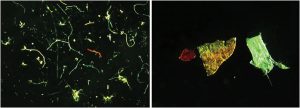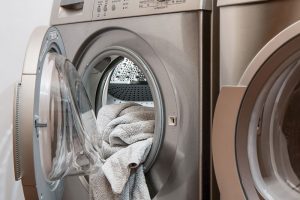
The textile industry can work together to formulate solutions to tackle to complex issue of microplastics in the environment.
By Dr. Davis Lee, Dr. Erin Kirkpatrick, Dr. A. Sydney Gladman and Dr. Donald Ripatti1
Microplastics are a growing concern for the textile industry, compounding the complexities of the broader sustainability discussion. Yet, there is much to be discovered about this multifaceted issue, and how to best respond to it.
At present, there is no broad-based agreement on a single definition for microplastic. The National Oceanic and Atmospheric Administration (NOAA) defines micro plastics as “plastic pieces less than 5 millimeters [mm} long which can be harmful to our ocean and aquatic life.” 2
The European Chemicals Agency (ECHA) are more specific in its proposed definition:
“‘microplastic’ means particles containing solid polymer, to which additives or other substances may have been added, and where ≥ 1 [percent] w/w of particles have:
(i) all dimensions 0.1 µm [micrometers] ≤x ≤ 5 mm, or
(ii) for fibers, a length of 0.3µm ≤ x ≤ 15 mm and length to diameter ratio of >3.” 3
The study of marine microplastics is not new. Woods Hole Oceanographic Institution (WHOI) has been conducting research and publishing on this subject since the 1970s.4 Other organizations have been active as well. For instance, the Science Advice for Policy by European Academies (SAPEA) consortium has published an extensive review pointing out the need for standardization and harmonization of testing methodologies. SAPEA states that there is “no evidence of widespread risk to human health from [nano/micro plastics] at present.” 5
While the quantification of the ocean plastics issue remains a challenge, researchers estimate that 4.8 to 12.7 million tons of plastic waste are expected to enter the ocean every year, with current accumulation estimated at 50-150 million tons.6 As of 2014, researchers have estimated that a minimum of 5.25 trillion pieces of plastic, weighing roughly 269,000 tons, persist at the surface level of our world’s oceans.7 In surface water, sampling studies have indicated that microplastics may exist in a wide range of concentrations; roughly 1×10-3 to 10 particles per liter for particles greater than 0.3 mm.8
As regulatory bodies are actively engaged in drafting rules and regulations that could affect the industry as well as consumers, it is important to understand the issues in order to respond appropriately.

The Problem For Textiles
Current aquatic sampling for microplastics finds that fibers are the second most identified “shape” of microplastics.9 However, the focus on surface-skimming sampling methods may not accurately quantify the amount of fiber that is present. Polyethylene terephthalate (PET), nylon, and acrylic fibers have densities greater than seawater, and are thus thought to accumulate at the seabed — an emerging subset of microplastic research.10 While researchers generally believe most microplastics originate from the fragmentation of larger pieces of plastic over time, it is unclear if this is the case for textile-derived microplastics.11
Many studies on microplastic release from textiles have focused on home laundering as a source of fibers entering the waterways. These studies have found shedding to be dependent on the properties of the textile article including fiber material, yarn size, fabric construction, fabric weight and fabric finishing.12 For example, polyester fleece has been identified in multiple studies to release higher fiber counts — >7000 fibers/m-2/L-1 — than other types of polyester fabrics.13 Variability in laundering equipment and settings as well as detergents also can influence the amount of fibers released from a garment or article, where both washers and dryers can result in shedding of textile fibers. Other studies have identified a 3.5-fold increase in fiber release during tumble drying as compared to the wash process for polyester fleece articles.14
Other potential sources of textile-derived microplastics in the environment may include fragmentation of fishing ropes and netting, or from breakdown of improperly discarded nonwoven hygiene products.15 In addition, the role of household-level filtration and wastewater treatment in preventing the release of microplastics to the environment requires further investigation.
Standards And Certifications
Currently, there are few standards to guide the industry on best practices for measuring the emission rates of microplastics from textiles. Industry recognized standards and environmental labels like ISO 14000 environmental management standards, ASTM environmental standards, Global Organic Textile standard, EU Ecolabel, OEKO-TEX® labeling standards do not yet include an evaluation of fiber shedding.
However, other industry testing organizations and independent researchers have been working to develop reproducible methods to help educate and support the industry. For example, the American Association of Textile Chemists and Colorists (AATCC), Research Triangle Park, N.C., is developing a gravimetric method of calculating fiber/mass loss using an accelerated laundering machine.16 The Hohenstein Institute, Germany, has developed a suite of test methods designed to provide a quantitative analysis of microfibers. These test methods include a gravimetric method adopted from the University of Leeds/The Microfibre Consortium Method, an assessment of fiber count, shape, and size distribution using Hohenstein’s method for Dynamic Image Analysis, and an assessment of cellulosic versus non-cellulosic content.17 Further, there are some standardized test methods that that may have the ability to be modified to directly evaluate microplastics. For example, test methods for evaluating dry lint count and laundering.18

Regulations
Currently, microplastics legislation has primarily targeted the sale or production of personal care products which contain microplastics. However, more comprehensive legislation is on the horizon. In August 2019, the European Chemicals Agency (ECHA), drafted an amendment to Registration, Evaluation, Authorization and Restriction of Chemicals (REACH) that would ban the sale of “microplastics on their own or in mixtures where their use will inevitably result in releases of microplastics to the environment, irrespective of the conditions of use” in the European Union zone. The proposed amendment defines microplastic (see ECHA definition above) containing materials as:
“… a substance on its own or in a mixture as a microplastic in a concentration equal to or greater than 0.01 [percent] w/w.”
Polymers that occur in nature and that have not been chemically modified — other than by hydrolysis — are excluded, as are polymers that are biodegradable. In addition, this proposed legislation would only apply to intentionally added microplastics, which are present at the point of use and could foreseeably be released to the environment. Products which generate or shed microplastics at the point of use or disposal, but did not originally contain added microplastics as defined above, would not be subject to this proposed regulation. Committee for Socio-economic Analysis (SEAC) will issue a final opinion on the legislation by September.19 A draft of the legislation by the European Commission is due in December 2020,20 and will likely be put to a final vote in 2021.
Currently, unmodified natural and biodegradable polymers are not regulated as microplastics under the proposed regulation. Natural fibers are defined under REACH as per their origin, not by their chemical structure. For example, polymers which occur naturally but are polymerized in an industrial setting would be regulated.21 The biodegradability of a polymer will be assessed by ISO 17025 certified laboratories which conduct approved tests outlined in the proposed REACH legislation to ensure that a polymer meets the target specifications for a biodegradable material.22
In the United States, microplastic regulations are being debated at the state level. In June, the California State Water Board adopted a definition of microplastics following the requirement in California Senate Bill No. 1422. The definition of microplastics in drinking water are defined as:
“Solid polymeric materials to which chemical additives or other substances may have been added, which are particles which have at least three dimensions that are greater than 1 [nanometer] and [have a volume] less than 5,000 micrometers (µm).3 Polymers that are derived in nature that have not been chemically modified (other than by hydrolysis) are excluded.” 23
Due to the dimensional constraints given, the threshold length for a man-made fiber will ultimately depend on its diameter. In addition, SB 1422 requires that a quantification methodology for the above definition of microplastics in drinking water be developed by July 1, 2021.24 Another California senate bill, SB 1263, mandates that a statewide microplastics strategy to protect ocean waters from microplastics to be developed on or before December 31, 2021.25
State-level legislation related to microplastics is expected to grow. And, as fibers are a commonly detected microplastic shape,26 it is likely that the textile industry will be impacted. What can the industry do? Become familiar with the issues and consumer concerns and work with trade associations, standards organizations, regulatory bodies and research organizations to formulate coherent and sensible solutions. Microplastics in the environment is a challenging and complex issue. However, working together, and employing sound science to understand and address the issue should help to provide a better environment and a stronger industry.
References:
1 The authors are consultants in the Polymer Science and Materials Chemistry practice of Exponent, Inc., a science and engineering consulting firm. This publication was authored by employees of Exponent, Inc. No portion of this publication has been funded or paid for by external sources.
2 What are microplastics? National Ocean Service website, https://oceanservice.noaa.gov/facts/microplastics.html, accessed on July 6, 2020.
3 Committee for Risk Assessment and Committee for Socio-economic Analysis: Opinion on an Annex XV dossier proposing restrictions on intentionally-added microplastics, https://echa.europa.eu/documents/10162/5a730193-cb17-2972-b595-93084c4f39c8 accessed on July 30, 2020.
4 Lubofsky, E. Microplastics in the Ocean – Separating Fact from Fiction, https://www.whoi.edu/oceanus/feature/whoi-viewpoint-microplastics-in-the-ocean-separating-fact-from-fiction/, accessed on July 6, 2020.
5 SAPEA, A Scientific Perspective on Microplastics in Nature and Society, https://www.sapea.info/wp-content/uploads/report.pdf accessed on 7/6/20.
6 Jambeck, J., et al. Plastic waste inputs from land into the ocean. Science, 347. 6223:768–771 (2015).
7 Eriksen M, Lebreton LCM, Carson HS, Thiel M, Moore CJ, et al. (2014) Plastic Pollution in the World’s Oceans: More than 5 Trillion Plastic Pieces Weighing over 250,000 Tons Afloat at Sea. PLoS ONE 9(12): e111913. doi:10.1371/journal.pone.0111913
8 A.A. Koelmans et al. Microplastics in freshwaters and drinking water: Critical review and assessment of data quality. Water Research 155 (2019) 410-422.
9 A.A. Koelmans et al. Microplastics in freshwaters and drinking water: Critical review and assessment of data quality. Water Research 155 (2019) 410-422.
10 F. Salvador Cesa et al. Synthetic fibers as microplastics in the marine environment: A review from textile perspective with a focus on domestic washings. Science of the Total Environment, 598 (2017) 1116–1129; Kane et al., Seafloor microplastic hotspots controlled by deep-sea circulation Science 368, 1140–1145 (2020).
11 Kormann, C. Where Does All the Plastic Go? The New Yorker (2019).
12 F. Salvador Cesa et al. Synthetic fibers as microplastics in the marine environment: A review from textile perspective with a focus on domestic washings. Science of the Total Environment, 598 (2017) 1116–1129; Carney Almroth, et al. Quantifying shedding of synthetic fibers from textiles; a source of microplastics released into the environment. Environ Sci Pollut Res (2018) 25:1191–1199; Cai et al. Systematic Study of Microplastic Fiber Release from 12 Different Polyester Textiles during Washing. Environ. Sci. Technol (2020) https://dx.doi.org/10.1021/acs.est.9b07395
13 Carney Almroth, et al. Quantifying shedding of synthetic fibers from textiles; a source of microplastics released into the environment. Environ Sci Pollut Res (2018) 25:1191–1199; Cai et al. Systematic Study of Microplastic Fiber Release from 12 Different Polyester Textiles during Washing. Environ. Sci. Technol (2020) https://dx.doi.org/10.1021/acs.est.9b07395; Pirc, U., et al. Emissions of microplastic fibers from microfiber fleece during domestic washing. Environ Sci Pollut Res (2016) 23:22206–22211.
14 Pirc, U., et al. Emissions of microplastic fibers from microfiber fleece during domestic washing. Environ Sci Pollut Res (2016) 23:22206–22211.
15 F. Salvador Cesa et al. Synthetic fibers as microplastics in the marine environment: A review from textile perspective with a focus on domestic washings. Science of the Total Environment, 598 (2017) 1116–1129.
16 UL: Addressing the environmental impact of microfibers in textiles, https://crs.ul.com/wp-content/uploads/2019/07/CRS_041_Microfiber-White-Paper_v4.pdf accessed July 7, 2020.
17 Hohenstein. Real data for sustainable material development: Quantitative analysis of microfibers, https://www.hohenstein.us/en-us/expertise/sustainability/microfibers/ accessed on July 14, 2020.
18 Jonsson, C., et al. Microplastics Shedding from Textiles—Developin Analytical Method for Measurement of Shed Material Representing Release during Domestic Washing. Sustainability 2018, 10, 2457; International Organization for Standardization. ISO 9073-10:2003 Textiles—Test Methods for Nonwovens—Part 10: Lint and Other Particles Generation in the Dry State; International Organization for Standardization. ISO 105-E03:2010 Textiles—Tests for Colour Fastness to Chlorinated Water.
19 ECHA. Registry of restriction intentions until outcome: microplastics, https://echa.europa.eu/registry-of-restriction-intentions/-/dislist/details/0b0236e18244cd73 accessed July 30, 2020; Committee for Risk Assessment and Committee for Socio-economic Analysis: Opinion on an Annex XV dossier proposing restrictions on intentionally-added microplastics, https://echa.europa.eu/documents/10162/5a730193-cb17-2972-b595-93084c4f39c8 accessed on July 30, 2020.
20 ECHA. Restriction procedure, https://echa.europa.eu/regulations/reach/restrictions/restriction-procedure accessed July 30, 2020.
21 Committee for Risk Assessment and Committee for Socio-economic Analysis: Opinion on an Annex XV dossier proposing restrictions on intentionally-added microplastics, https://echa.europa.eu/documents/10162/5a730193-cb17-2972-b595-93084c4f39c8 accessed on July 30, 2020.
22 ECHA. ANNEX XV Restriction Report: intentionally added microplastics, https://echa.europa.eu/documents/10162/05bd96e3-b969-0a7c-c6d0-441182893720 accessed on August 1, 2020.
23 California Water Boards. Proposed Definition of ‘Microplastics in Drinking Water,’ https://www.waterboards.ca.gov/drinking_water/certlic/drinkingwater/docs/dfntn_jun3.pdf accessed July 30, 2020.
24 California Senate Bill No. 1422, https://leginfo.legislature.ca.gov/faces/billTextClient.xhtml?bill_id=201720180SB1422 accessed July 30, 2020.
25 California Senate Bill No. 1263, https://leginfo.legislature.ca.gov/faces/billTextClient.xhtml?bill_id=201720180SB1263 accessed July 30, 2020.
26 A.A. Koelmans et al. Microplastics in freshwaters and drinking water: Critical review and assessment of data quality. Water Research 155 (2019) 410-422.
Editor’s Notes: Dr. Davis Lee is senior managing scientist, Dr. Erin Kirkpatrick is managing scientist, Dr. A. Sydney Gladman is manager, and Dr. Donald Ripatti is a scientist in the Polymer Science & Materials Chemistry practice of Exponent Inc. — a multi-disciplinary engineering and scientific consulting firm.
September/October 2020




